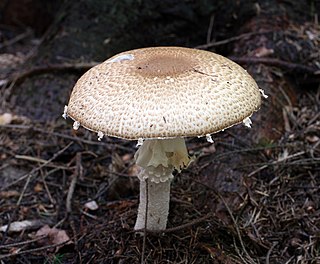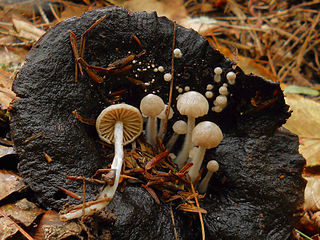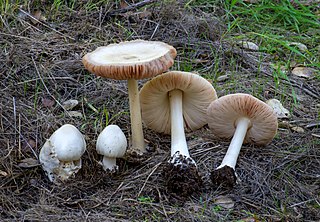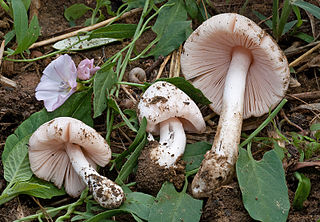
The Agaricaceae are a family of basidiomycete fungi and include the genus Agaricus, as well as basidiomycetes previously classified in the families Tulostomataceae, Lepiotaceae, and Lycoperdaceae.

In mycology, a partial veil is a temporary structure of tissue found on the fruiting bodies of some basidiomycete fungi, typically agarics. Its role is to isolate and protect the developing spore-producing surface, represented by gills or tubes, found on the lower surface of the cap. A partial veil, in contrast to a universal veil, extends from the stem surface to the cap edge. The partial veil later disintegrates, once the fruiting body has matured and the spores are ready for dispersal. It might then give rise to a stem ring, or fragments attached to the stem or cap edge. In some mushrooms, both a partial veil and a universal veil may be present.

Agaricus augustus, known commonly as the prince, is a basidiomycete fungus of the genus Agaricus.

Neolentinus ponderosus, commonly known as the giant sawgill, or ponderous lentinus, is a species of fungus in the family Gloeophyllaceae. Found in western North America, it was originally described in 1965 as a species of Lentinus by American mycologist Orson K. Miller.

Clitocybe nebularis or Lepista nebularis, commonly known as the clouded agaric, cloudy clitocybe, or cloud funnel, is an abundant gilled fungus which appears both in conifer-dominated forests and broad-leaved woodland in Europe and North America. Appearing in Britain from mid to late autumn, it is edible, but may cause gastrointestinal issues.

Hebeloma radicosum, commonly known as the rooting poison pie, is a species of agaric fungus in the family Hymenogastraceae. Fruit bodies (mushrooms) can be identified by the tapering root-like stipe base, as well as the almond-like odor. Found in Japan, Europe, and North America, it is an ammonia fungus, and fruits on mole, mouse, or shrew middens.

Agaricus deserticola, commonly known as the gasteroid agaricus, is a species of fungus in the family Agaricaceae. Found only in southwestern and western North America, A. deserticola is adapted for growth in dry or semi-arid habitats. The fruit bodies are secotioid, meaning the spores are not forcibly discharged, and the cap does not fully expand. Unlike other Agaricus species, A. deserticola does not develop true gills, but rather a convoluted and networked system of spore-producing tissue called a gleba. When the partial veil breaks or pulls away from the stem or the cap splits radially, the blackish-brown gleba is exposed, which allows the spores to be dispersed.

Agaricus hondensis, commonly known as the felt-ringed agaricus, is a species of fungus in the family Agaricaceae. The species was officially described in 1912 by mycologist William Alphonso Murrill, along with three other Agaricus species that have since been placed in synonymy with A. hondensis. Found in the Pacific Northwest region of North America, A. hondensis fruits in the fall under conifers or in mixed forests.

Mycena aurantiomarginata, commonly known as the golden-edge bonnet, is a species of agaric fungus in the family Mycenaceae. First formally described in 1803, it was given its current name in 1872. Widely distributed, it is common in Europe and North America, and has also been collected in North Africa, Central America, and Japan. The fungus is saprobic, and produces fruit bodies (mushrooms) that grow on the floor of coniferous forests. The mushrooms have a bell-shaped to conical cap up to 2 cm in diameter, set atop a slender stipe up to 6 cm long with yellow to orange hairs at the base. The fungus is named after its characteristic bright orange gill edges. A microscopic characteristic is the club-shaped cystidia that are covered with numerous spiky projections, resembling a mace. The edibility of the mushroom has not been determined. M. aurantiomarginata can be distinguished from similar Mycena species by differences in size, color, and substrate. A 2010 publication reported the discovery and characterization of a novel pigment named mycenaaurin A, isolated from the mushroom. The pigment is responsible for its color, and it has antibiotic activity that may function to prevent certain bacteria from growing on the mushroom.

Asterophora parasitica, commonly known as the parasitic Asterophora or the Russula parasite, is a species of fungus that grows as a parasite on other mushrooms. The fruit bodies are small, with silky fibers on the surface of grayish caps and thick, widely spaced gills. Mushrooms fruit in clusters on the decaying remains of Lactarius and Russula species, particularly those in the Russula nigricans group. Found primarily in temperate zones of Europe and North America, the fungus is widespread but not common.

Hygrophorus purpurascens, commonly known as the purple-red waxy cap, is a species of agaric fungus in the family Hygrophoraceae. Its cap has a pink background color with streaks of purplish red overlaid, and mature gills have red spots.

Volvopluteus gloiocephalus, commonly known as the big sheath mushroom, rose-gilled grisette, or stubble rosegill, is a species of mushroom in the family Pluteaceae. For most of the 20th century it has been known under the names Volvariella gloiocephala or Volvariella speciosa, but recent molecular studies have placed it as the type species of the genus Volvopluteus, newly created in 2011. The cap of this mushroom is about 5–15 cm (2–6 in) in diameter, varies from white to grey or grey-brown, and is markedly sticky when fresh. The gills start out as white but they soon turn pink. The stipe is white and has a sack-like volva at the base. Microscopical features and DNA sequence data are of great importance for separating V. gloiocephalus from related species. V. gloiocephalus is a saprotrophic fungus that grows on grassy fields and accumulations of organic matter like compost or woodchips piles. It has been reported from all continents except Antarctica.

Volvariella bombycina, commonly known as the silky volvariella, silky sheath, silky rosegill, silver-silk straw mushroom, or tree mushroom, is a species of edible mushroom in the family Pluteaceae. It is an uncommon but widespread species, having been reported from Asia, Australia, the Caribbean, Europe, and North America. The fruit body (mushroom) begins developing in a thin, egg-like sac. This ruptures and the stem expands quickly, leaving the sac at the base of the stem as a volva. The cap, which can attain a diameter of up to 20 centimetres, is white to slightly yellowish and covered with silky hairs. On the underside of the cap are closely spaced gills, free from attachment to the stem, and initially white before turning pink as the spores mature. The mushroom grows singly or in clusters, often appearing in old knotholes and wounds in elms and maples. V. bombycina contains compounds with antibacterial properties.

Psathyrella ammophila is a species of fungus in the family Psathyrellaceae and is found throughout Europe. Commonly known as the dune brittlestem, this agaric primarily grows on sand dunes near marram grass, feeding saprotrophically on the decaying roots. The season of growth is generally May to November.

Strobilurus tenacellus, commonly known as the pinecone cap, is a species of agaric fungus in the family Physalacriaceae. It is found in Asia and Europe, where it grows on the fallen cones of pine and spruce trees. The fruit bodies (mushrooms) are small, with convex to flat, reddish to brownish caps up to 15 mm (0.6 in) in diameter, set atop thin cylindrical stems up to 4–7.5 cm (1.6–3.0 in) long with a rooting base. A characteristic microscopic feature of the mushroom is the sharp, thin-walled cystidia found on the stipe, gills, and cap. The mushrooms, sometimes described as edible, are too small to be of culinary interest. The fungus releases compounds called strobilurins that suppress the growth and development of other fungi. Derivatives of these compounds are used as an important class of agricultural fungicides.

Volvopluteus earlei is a species of mushroom in the family Pluteaceae. It was originally described in 1911 by American mycologist William Alphonso Murrill as Volvariopsis earlei, based on collections made in a Cuban banana field. The fungus was later shuffled to the genera Volvaria and Volvariella before molecular studies placed it in Volvopluteus, a genus newly described in 2011.

Mycena purpureofusca, commonly known as the purple edge bonnet, is a species of agaric fungus in the family Mycenaceae. First described by Charles Horton Peck in 1885, the species is found in Europe and North America, where it grows on the decaying wood and debris of conifers, including cones. Fruit bodies have conical to bell-shaped purple caps up to 2.5 cm (1 in) set atop slender stipes up to 10 cm (4 in) long. The mushroom is named for the characteristic dark greyish-purple color of its gill edges. In the field, M. purpureofusca mushrooms can usually be distinguished from similar species by characteristics such as the dark purple gill edges, the deep purple cap center, and its cartilagineous consistency. The fungus contains a laccase enzyme that has been investigated scientifically for its potential to detoxify recalcitrant industrial dyes used in textile dyeing and printing processes.

Amanita ananiceps is a species of agaric fungus in the family Amanitaceae native to Australia.

Hygrophorus erubescens, commonly known as the blotched woodwax or pink waxcap, is an agaric fungus native to Scandinavia, Japan, Central Europe, Great Britain and North America.

Stropharia caerulea, commonly known as the blue roundhead, is a species of mushroom forming fungus in the family Strophariaceae. It is a somewhat common species found in Europe and North America, where it grows as a saprophyte in meadows, roadsides, hedgerows, gardens, and woodchip mulch. S. caerulea was officially described to science in 1979, although it was known to be a distinct species for about two centuries before that. The scientific name Stropharia cyanea, as defined by Tuomikoski in 1953, and used by several later authors, is a synonym of S. caerulea.























